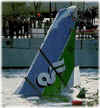|
ETOPS is an acronym for Extended-Range Twin-Engine Operations. Without an ETOPS
rating, an aircraft with only two engines must be able to get to an airport where it can
safely land within 60 minutes if an engine fails in-flight. ETOPS extends this "rule
time" to 90 minutes or more, up to a maximum of 180 minutes. Obtaining an
ETOPS rating requires certification of the reliability of an airframe/engine combination
as well as an airline's flight operations and maintenance schedule. Usually extra
equipment is required as well, such as additional backup systems for electrical power.
ETOPS does not require over-water equipment (e.g., life rafts) or additional fuel tanks,
though these are usually required for the typical missions of ETOPS-rated aircrafts.
Some pilots claim ETOPS really means "Engines Turn Or Passengers Swim..."

Why are
there restricted areas over large parts of South America, Africa, and other continents?
The database of suitable alternate airports is incomplete. For some areas, such as the
North Atlantic, very good data is readily available. It also doesn't take a rocket
scientist to figure out that many airports in the U.S. which have regularly scheduled service with large, widebody
airliners are suitable alternates. For other parts of the world, such as the North
Pacific, the data isn't readily available...
Most of
the rule-times make sense, but why 138 minutes?
There are two distinct routes across the North Atlantic, one using Iceland's Keflavik
airport as a key alternate, and another, more southerly route using Lajes in the Azores.
West of these islands, there's a small, triangular area which is not within 120 minutes of
any suitable airport. A 138 minute rule-time (120 minutes plus 15%) removes this last
"no-go" area over the North Atlantic. (180 minute ETOPS is significantly more difficult, and with no
reason for it over the Atlantic, many carriers neither need nor want the added expense.)
240 (and
207) minute rule-times for ETOPS?! I thought 180 minutes was the highest.
There has been some
discussion recently about extending ETOPS rules to allow a 240 minute rule-time, with an
interim proposal for 207 minutes (180 minutes plus 15%, similar to the 138 minute
rule-time). This closes some restricted areas above the Arctic Circle which could prove
commercially interresting for flights between North America and parts of Asia.
It would also allow closure of alternate airports along routes which currently can be
served under less stringent ETOPS rules, such as Midway Island (MDY), which is currently
subsidized in part by Boeing to provide an ETOPS alternate. This fact has pilots
concerned since it affects all planes, not just twins. They note that even if all
engines are still running (and at this point twins aren't significantly more likely to
divert due to engine failure than aircraft with three or more engines), a four hour
diversion due to a fire or a medical emergency or any one of a number of other problems is
an awfully long time.
(See AW&ST, November 30, 1998, pp. 50-51.)
See also the "Great
Circle Path display", http://www.chicago.com/airliners/gc.html
|